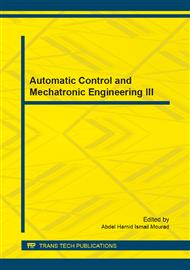p.301
p.305
p.309
p.313
p.317
p.323
p.329
p.335
p.343
Experimental Study of Compliant Mechanism Considering Thermal Effect
Abstract:
In this paper, an ultra-precision positioning stage is introduced. The finite element method is used to establish the theoretical model, and the strain test system of experiment is established. The system includes the static strain test and the dynamic strain test. The test system contains the software and hardware system. The software system includes the static strain measurement software of DH3816, the programmable constant temperature and humidity chamber control software TEMI300, and the dynamic strain test system developed from NI Labview. The hardware system contains industrial personal computer (IPC), piezoelectric (PZT) actuator, static strain gauge of DH3816, strain amplifier of YE1817, NI USB-6009 multifunction data acquisition card, strain gauge, programmable temperature and humidity chamber, and precision positioning stage. The experimental test is carried out to examine the theoretical analysis considering thermal effect. Experimental results and analytical results indicate that whether the stresses increase or decrease linearly or nonlinearly depend on the function of the temperature to the time during the transient response same as the stresses increase or decrease linearly during the steady response under uniform temperature change. The dynamic responses of platform are affected by the temperature change, and it is essential to consider thermal effect when analyzing compliant mechanisms.
Info:
Periodical:
Pages:
317-322
Citation:
Online since:
August 2014
Authors:
Price:
Сopyright:
© 2014 Trans Tech Publications Ltd. All Rights Reserved
Share:
Citation:


